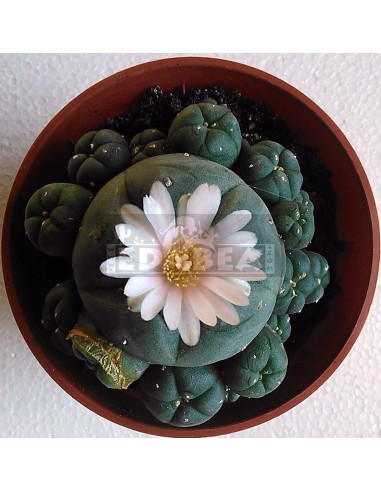Peyote cactus multi head
Peyote cactus multi-head v.caespitosa.
Peyote, Lophophora Williamsii
Lophophora Williamsii, the peyote cactus, is the best known mescaline cactus. Mescaline is a psychoactive substance that causes psychedelic hallucinations. Peyote has the highest mescaline content and the strongest effect of all psychedelic cacti. Native to Mexico and South Texas, it is the slowest growing cactus in the world. The mature Peyote cactus contains more mescaline than young specimens of the same size, but also, in the small cactus, the odor and bitter taste of mescaline is evident. The highest concentration of mescaline is in the outer part (epidermis).
In addition to mescaline, Peyote contains more than 50 different types of alkaloids and active substances.
The alkaloid Mescaline (chemical name 3, 4,5-Trimethoxybenzeneethanamine) occurs in nature, almost exclusively in cacti. Lophophora Williamsii is green to blue-green/blue-gray in color.
Peyote is normally a small sized cactus. Cacti that are planted with lots of sun, little water and little fertilizer are stronger and have more mescaline. They can easily withstand temperatures of -8 degrees in winter, and high temperatures in summer.
Peyote does not have thorns, but clusters of white hairs where the seeds are formed. The root of the peyote is white, large and thick with a diameter that can be as large as the diameter of the Peyote itself. From this main root grow small lateral roots. The root contains little or no mescaline and is not eaten.
If the root stays in the ground it can continue to grow and form new shoots. The flowers are pale pink to white. The flowers grow in the center of the plant, sometimes with several flowers at a time. Flower formation means that the plant is growing well. From March to early October the plant may flower every three weeks.
The indigenous tribes of Mexico harvest Peyote cacti from the wild. Dried Peyote buds are used as medicine in religious ceremonies. Participants consume several Peyote buds, led by a shaman.
Indians eat Peyote on an empty stomach. They chew Peyote slices for a long time so that the mescaline is absorbed through the oral mucosa. Sometimes they infuse it. The cactus is cut into small pieces and boiled for half an hour. After this time, it can be drunk. The tea is also kept in the mouth for a while before swallowing. Side effects often occur after the first hour of ingestion such as, nausea, abdominal cramps and sweating, but these effects disappear when the journey begins. It is difficult to say how much to eat because the mescaline content can be very different depending on the cactus. 12-30 grams is an average dose. You can eat half of the dose and wait 60-90 minutes before eating the rest. The effect can last 6-12 hours. 50-60 grams is usually enough for most if you want to get a very strong effect that can last up to 18 hours.
Cacti need much less water than other plants. During the growing season (July, August) you can water once or maximum twice a month. From October to the end of April they need practically no watering.
All Trichocereus cacti, of the columnar type, can be eaten both in infusion and by chewing their flesh. You will find a detailed description below, in the Trichocereus Pachanoi paragraph. It is advisable to have a sober person in the group and to take the cactus in a place where one feels safe and secure. Indians enjoy its well-informed effect. According to their philosophy it is not a game and they consider it as one of the most important spiritual experiences in their life. On the Internet there is a lot of information about it.
In general, this type of cactus needs a lot of sun, but not always directly. They need little water, in winter almost none. It is advisable to use a specific soil for cacti that you can get in any garden center. It is worth to be informed, but the experience that gives us the practice is the best.
SHIPPING RESTRICTIONS
Unfortunately we cannot ship this product to the following countries:
Finland, Portugal, Switzerland, Norway, France, Russia, Estonia, Turkey, Hungary, Mexico, Brazil, and Canada.
For the rest of the countries please check the current legislation, there may have been changes that we are not aware of.


